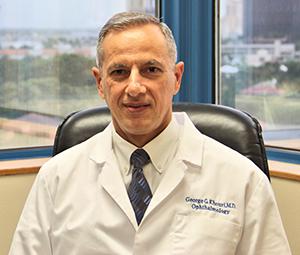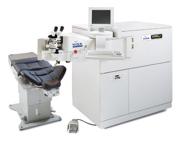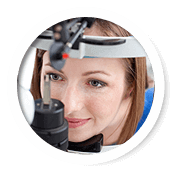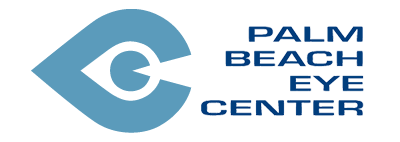What is Refractive Laser Surgery (LASIK)?
Refractive laser surgery eliminates or reduces the need for glasses by altering the shape of the cornea, thus changing the way the eye focuses light. These procedures are performed in only a few minutes using anesthetic eye drops.
LASIK (laser in-situ keratomileusis) is a laser vision correction procedure used to correct Refractive Errors such as nearsightedness, farsightedness, and astigmatism using the Excimer laser. This laser procedure was developed in South America, where Dr. George Khouri learned it from one of the world’s first — and most experienced – practitioners in 1996 before it was approved for use in the USA. LASIK was developed and first performed outside the USA in the early 1990s, primarily because it was not subject to our strict FDA regulations. LASIK was FDA approved in 1998. There have been no long term problems reported with LASIK since then. Most experts in the field are confident that the cornea will remain stable permanently, as long as patients are appropriately selected and the safe limit of tissue removal by the laser is not exceeded during the surgery in the case of high refractive errors. The skill and experience of the surgeon are also key factors.
Why Choose Dr. Khouri for LASIK?
Dr Khouri has performed the LASIK procedure on several of his peers in the community making him “the doctors’ doctor” and the premier West Palm Beach LASIK Surgeon. Dr. Khouri had the LASIK procedure performed on his own eyes. He strongly believes that LASIK is an excellent procedure yielding long lasting results.
has performed the LASIK procedure on several of his peers in the community making him “the doctors’ doctor” and the premier West Palm Beach LASIK Surgeon. Dr. Khouri had the LASIK procedure performed on his own eyes. He strongly believes that LASIK is an excellent procedure yielding long lasting results.
The success of the visual results following laser vision correction not only depends on excellent surgical skills but also on very accurate preoperative measurements of the refractive error and other corneal parameters to be programmed into the laser computer. Dr. Khouri personally takes and/or oversees all of these preoperative measurements and follows you closely preoperatively and postoperatively in contrast to some other practices that rely solely on their technicians for these tasks. When you choose a highly skilled surgeon, complications from any of these procedures are very rare. Actually, there is a lower risk of visual loss from LASIK than from long-term use of extended wear contact lenses. The reason is that the latter increases the risk of an infection such as a corneal ulcer which could lead to severe visual loss.
Why LASIK?
 Prior to the 1980s, physicians were making radial and arcuate incisions to reshape the surface of the cornea and treat myopia and astigmatism respectively. This is called radial keratotomy or RK. The goal of this procedure was to reduce or eliminate a lifetime of dependence on corrective lenses. Since these incisions were about 90% deep, the structural integrity of the cornea was compromised making it more prone to injury and more likely to cause fluctuations in vision due to instability.
Prior to the 1980s, physicians were making radial and arcuate incisions to reshape the surface of the cornea and treat myopia and astigmatism respectively. This is called radial keratotomy or RK. The goal of this procedure was to reduce or eliminate a lifetime of dependence on corrective lenses. Since these incisions were about 90% deep, the structural integrity of the cornea was compromised making it more prone to injury and more likely to cause fluctuations in vision due to instability.
Researchers found that the technologically advanced Excimer laser was extremely accurate. Its cool ultraviolet beam caused no thermal damage to the corneal tissue as compared to other lasers. The Excimer laser has achieved utmost precision so that it can remove tissue with up to 0.25 microns of accuracy. Laser vision correction also added predictability, stability, and safety to the surgical correction of Refractive Errors such as nearsightedness, farsightedness and astigmatism.
4 Types of Laser Vision Correction
There are four types of laser vision correction procedures available using the Excimer laser: PRK (photorefractive keratectomy), LASIK, LASEK (laser epithelial keratomileusis) and Epi-LASIK (epithelial laser in situ keratomileusis).
PRK
The first human eye ever treated with laser vision correction using PRK in the USA was in 1989 and this procedure was first approved by the FDA in 1995. In PRK, the epithelial surface layer of the cornea is gently removed using a brush. The Excimer laser reshapes the underlying superficial layer. The epithelial surface layer is then allowed to heal over by placing a contact lens for a few days.
There are two steps in how your vision is corrected with LASIK. The first step creates a corneal flap with the femtosecond laser which uses ultrashort pulses (one femtosecond is equal to 10-15 second) that cut the corneal tissue using a photodisruption process. This flap is folded back to allow for the second step, which involves the reshaping of the exposed inner corneal surface with the Excimer laser. The corneal flap is then returned in its original position where it adheres securely without the need for stitches. . Most patients recover and see better very quickly.
LASIK
The IntraLase iFS femtosecond laser, which Dr Khouri uses, was the first laser to be FDA approved for creating a corneal flap during the LASIK procedure in 2002. Prior to the development of the femtosecond laser, the corneal flap was created by a surgical instrument called a microkeratome. The rate of flap complications associated with the microkeratome and dry eye symptoms is greatly reduced with the use of the Intralase iFS femtosecond laser. Since the flap created with the femtosecond laser is thinner than when a microkeratome is used, there is more corneal tissue available to treat so you could still be a candidate for this procedure if you have a larger refractive error. In addition, the laser created flap is a more precisely predictable flap than with the blade of a microkeratome giving a superior visual result.
LASEK
LASEK combines some steps from both PRK and LASIK. With LASEK, a flap of the surface epithelial layer is loosened with a diluted alcohol solution and lifted prior to treatment of the underlying superficial layer with the Excimer laser. The flap is repositioned as with LASIK. A protective contact lens is then placed over the cornea to allow the surface epithelial layer to heal.
EPI-LASIK
Epi-LASIK is another surface ablation procedure very similar to LASEK where the surface epithelial layer of the cornea is removed with a specially designed mechanical instrument called an epithelial separator to create a thin flap of corneal epithelium. No alcohol is needed to soften or loosen the epithelial cells. The Excimer laser is then used to reshape the cornea and a contact lens is placed to allow the corneal epithelium to heal.
Since LASIK is performed in a deeper layer under a protective flap of corneal tissue, healing is faster with minimal post-operative discomfort, and more rapid visual recovery as compared to PRK, LASEK and Epi-LASIK.
What Type of Laser Vision Correction is Best for You?
PRK, LASEK and Epi-LASIK, are considered surface ablation procedures. These procedures may result in a more predictable outcome with Custom Laser Vision Correction as compared to LASIK because the treated area is closer to the surface epithelial layer where the high order aberrations are measured using the wavefront analysis obtained with the iDesign Advanced WaveScan Studio System. These procedures can also be advantageous in patients with a tendency toward dry eye as compared to LASIK because a deeper flap is avoided. They are also advantageous for patients with thinner corneas since the created flap is much thinner than with LASIK. The amount of refractive error that can be treated is also greater than with LASIK. If you are a very physically active individual, the risk of traumatic flap dislocation is avoided with these procedures.
How Do LASIK Consultations and Comprehensive Preoperative Visits Work?
1. The LASIK Consultation Visit at Palm Beach Eye Center
This is an initial visit which is free of charge. Preliminary examinations can establish if LASIK or another laser vision correction procedure is right for you depending on your visual goals in terms of decreasing or eliminating your dependence on glasses for distance and/or near vision. Your lifestyle and medical history are critical components of the consultation. Please discuss your family history of eye diseases and health concerns and your medications and supplements.
 Some of these examinations include measurement of: your vision (with and without glasses); current eyeglass prescription, which represents low-order aberrations of your visual system; and optical imperfections of your visual system, which are high-order aberrations. (LASIK corrects both high- and low-order aberrations when Custom LASIK or traditional LASIK is chosen.) Other examinations include corneal thickness, testing of the pupil size, corneal curvature and mapping of the cornea. These examinations are necessary to determine LASIK candidacy.
Some of these examinations include measurement of: your vision (with and without glasses); current eyeglass prescription, which represents low-order aberrations of your visual system; and optical imperfections of your visual system, which are high-order aberrations. (LASIK corrects both high- and low-order aberrations when Custom LASIK or traditional LASIK is chosen.) Other examinations include corneal thickness, testing of the pupil size, corneal curvature and mapping of the cornea. These examinations are necessary to determine LASIK candidacy.
Dr. Khouri will determine, based on the above examinations, whether you are a candidate for any of the available procedures, and he will discuss your options with you. He might recommend delaying surgery until such time as your prescription becomes stable based on your history and review of records from previous eye physicians who were taking care of you. This determination is crucial as it optimizes visual success and long-lasting results. Once LASIK candidacy is determined, Dr. Khouri will outline the procedure and move forward with scheduling your LASIK surgery.
2. The LASIK Comprehensive Preoperative Visit at Palm Beach Eye Center
This visit may take two hours or longer. During this time, our board-certified ophthalmologist will evaluate your eyes, your vision and overall well-being for a complete assessment.
Dr. Khouri will take highly detailed measurements of your eyes for accurate mapping of refractive errors.
The data from this appointment will be used by the computer-guided laser for the LASIK procedure or other vision correction procedure that is specifically planned, depending on your eye examination characteristics and your needs.
The comprehensive preoperative visit involves a series of tests to determine the eye’s focusing ability and establish the retina’s health and function. A dilated eye exam with eye drops allows our ophthalmologist to peer inside the eye to evaluate the retina and other anatomical structures. Dr. Khouri will determine how well your tear film functions by assessing volume and composition on the eye’s surface and performing other eye measurements to screen for eye disease, allergies and infection.
Many essential measurements and diagnostic tests are necessary during the LASIK consultation to ensure laser eye surgery is the best move for your vision and eye health and to maximize the potential for an excellent visual outcome.
How Much Does LASIK Cost?
 There is a broad price range for LASIK in the United States, and a low price should not be the determining factor when choosing your LASIK surgeon. The average cost of LASIK in 2020 was $2,632 per eye, according to Clinical Ophthalmology, but it may be as high as $4,000 per eye in some locations. This expense includes your consultation, procedure, recovery supplies and follow-up visits at Palm Beach Eye Center.
There is a broad price range for LASIK in the United States, and a low price should not be the determining factor when choosing your LASIK surgeon. The average cost of LASIK in 2020 was $2,632 per eye, according to Clinical Ophthalmology, but it may be as high as $4,000 per eye in some locations. This expense includes your consultation, procedure, recovery supplies and follow-up visits at Palm Beach Eye Center.
Be wary of discounted prices or low LASIK fees as they may not include pre- and post-operative care. Choose your LASIK surgeon based on their experience, bedside manner and patient testimonials, not on the price of the procedure. During your consultation, ask what is included in the LASIK cost, and our office can provide you with a detailed quote.
The long-lasting success of the procedure is highly dependent on meticulous and precise measurements which can make a significant difference between an excellent uncorrected visual result and a good or mediocre result. Dr. Khouri oversees, reviews and does most of the crucial examinations himself in order to maximize your chances for an excellent visual result. He will not hesitate to repeat some of the tests if he notes any slight discrepancies between measurements. These discrepancies are a common phenomenon which occurs as more than one method or instrument is used to get the data which will need to be inserted in the laser machine for computer-guided treatment.
What are the Risks of LASIK?
While LASIK complications are rare, with less than 1 percent of patients experiencing severe adverse events, you need to understand the potential risks before your laser vision correction. Dr. Khouri will review the risks and complications associated with LASIK during your consultation.
The most common adverse side effects from LASIK are glare and halos around lights, dry eye and trouble with night vision, but these typically go away after the eye is healed. Ghosting and starbursts may also occur in patients temporarily. Some patients may experience these side effects for up to a year or longer after LASIK. Up to 30 percent of LASIK patients will experience these short-term side effects.
Statistically, a revision LASIK procedure is needed in less than 5% of patients to achieve better results. This is why making sure that you have a stable prescription — so called refractive stability — prior to surgery, combined with meticulous and precise measurements, are crucial to minimize this risk as outlined above. Severe complications from LASIK happen in fewer than 1% of patients and may involve infection and corneal flap dislocation.
According to the Refractive Surgery Council, available research reports that 96 percent of LASIK patients are satisfied with their results, which is a high success rate for any type of surgery.
LASIK FAQs
What is the right age to have LASIK?
 The ideal age range for LASIK surgery is 20-40 years of age, but many patients fall outside that range. What is most crucial is that a candidate’s prescription remains stable for at least six months prior to the procedure. While there’s no absolute upper age limit for LASIK, LASIK is not approved by the FDA for patients under 18 as their vision has not yet stabilized. Patients over 40 may begin to develop presbyopia (age-related farsightedness) and might need to explore additional corrective options for near vision.
The ideal age range for LASIK surgery is 20-40 years of age, but many patients fall outside that range. What is most crucial is that a candidate’s prescription remains stable for at least six months prior to the procedure. While there’s no absolute upper age limit for LASIK, LASIK is not approved by the FDA for patients under 18 as their vision has not yet stabilized. Patients over 40 may begin to develop presbyopia (age-related farsightedness) and might need to explore additional corrective options for near vision.
Does LASIK hurt?
LASIK surgery involves minimal discomfort thanks to the numbing drops applied to the eyes before the procedure. Patients may feel pressure but should not experience pain during the surgery. Post-operative discomfort, including mild itching or burning sensations, is possible but typically subsides within a few hours. Typically, over-the-counter pain medication is sufficient to keep you comfortable.
How long is LASIK recovery?
The recovery time for LASIK is remarkably short. Many patients report significant improvements in vision within the first 48 hours. Focus on resting your eyes for the first day, avoiding eye-straining activities like reading or watching television. You should also avoid rubbing or putting pressure on your eyes. Most individuals can resume their normal activities within a day or two, following their doctor’s post-operative care instructions.
Are LASIK results permanent?
LASIK permanently reshapes the cornea, which means the vision correction achieved is permanent. However, it does not prevent natural age-related changes in the eye, such as presbyopia or cataracts. Some patients might choose to have a touch-up procedure years later if their vision changes with age.
How is LASIK different from refractive lens exchange?
 LASIK and refractive lens exchange (RLE) are both designed to correct vision, but they work in different ways. LASIK involves reshaping the cornea with a laser to correct vision issues like nearsightedness, farsightedness, and astigmatism. RLE, on the other hand, replaces the eye’s natural lens with an artificial one to achieve clearer vision, typically used for patients over 45 or those with presbyopia or high hyperopia. RLE can give simultaneous near and distance vision without glasses in each eye as compared to LASIK which can only give near vision out of one eye and distance vision out of the other using monovision correction as described below in the last paragraph. The choice between LASIK and RLE depends on the patient’s age, eye health, and specific vision needs. Our eye team can evaluate your candidacy for both procedures and help to determine the best refractive surgery choice for you.
LASIK and refractive lens exchange (RLE) are both designed to correct vision, but they work in different ways. LASIK involves reshaping the cornea with a laser to correct vision issues like nearsightedness, farsightedness, and astigmatism. RLE, on the other hand, replaces the eye’s natural lens with an artificial one to achieve clearer vision, typically used for patients over 45 or those with presbyopia or high hyperopia. RLE can give simultaneous near and distance vision without glasses in each eye as compared to LASIK which can only give near vision out of one eye and distance vision out of the other using monovision correction as described below in the last paragraph. The choice between LASIK and RLE depends on the patient’s age, eye health, and specific vision needs. Our eye team can evaluate your candidacy for both procedures and help to determine the best refractive surgery choice for you.
What is Wavefront technology?
Wavefront technology represents an advanced method used in LASIK surgery to create a highly detailed map of the eye. This technology measures how light is distorted as it enters the eye, allowing for a custom LASIK procedure tailored to the unique imperfections of each eye. It enhances the precision of the surgery, potentially leading to sharper, higher-quality vision and reducing the risk of post-surgery complications like glare and halos around lights. 94% of patients who had the custom laser vision correction procedure during the FDA clinical trials, achieved 20/20 or better vision. The trial participants were 4 times more likely to say they were very satisfied with their night vision following custom laser vision correction than they were with their glasses or contact lenses.
Can LASIK correct presbyopia?
LASIK primarily corrects nearsightedness, farsightedness, and astigmatism but isn’t designed to directly address presbyopia, an age-related condition that affects close-up vision. However, techniques like monovision LASIK, where one eye is corrected for distance vision and the other for near vision, can be used to compensate for presbyopia. This approach may help reduce reliance on reading glasses, although it might not be suitable for everyone and can affect depth perception.
If you’re interested in laser vision correction, contact Palm Beach Eye Center in West Palm Beach, Florida. Schedule your free LASIK consultation with Dr. Khouri by calling 561-366-8300 or filling out our online contact form.









